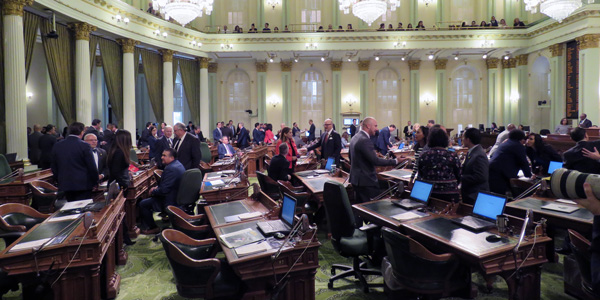By Jason Fordney
A key California lawmaker is seeking comment this week on a revived effort to regionalize CAISO and create a multistate Western RTO, an effort that has sputtered over the last two years.
State Assemblymember Chris Holden (D), chair of the Utilities and Energy Committee, is taking public comment through Wednesday on proposed amendments to AB 813, which would authorize CAISO’s Board of Governors to develop a governance proposal for an RTO that would eventually allow California to relinquish its direct oversight of the grid operator.
The bill stipulates that the plan would then be submitted to the California Energy Commission, which — along with the California Air Resources Board — would review the proposal and also take public comment. If the CEC determines the proposal complies with the law, and if one or more transmission owners signs an agreement to join the new RTO, CAISO would be authorized to implement the new governance structure.
“Composition of the new board would not trigger until CEC approval and an agreement with at least one new balancing authority to join,” committee staffer Kellie Smith told RTO Insider in an email.
The proposal would provide for the establishment of a Western States Committee with three representatives from each state with TOs in the new RTO to provide input. According to the bill’s language, states would preserve their authority over member balancing authority areas, including procurement policy, resource planning and generation, and transmission siting within their states.
Holden led a similar effort last year, but it stalled along with separate legislation that would establish a 100% zero-carbon energy requirement for utilities in the state. (See CAISO Regionalization, 100% Clean Energy Bills Stall.)
While some industry interests favor regionalization to create a wider market for power generation, California labor unions have expressed concerns that the effort could export jobs to other states, and some state officials also worry about losing control over the state’s aggressive renewable and climate change policies.
Regionalization has been a longstanding goal of Gov. Jerry Brown, who is serving out his last year as governor ahead of this November’s elections. Two years ago, he put the effort on hold because of unresolved questions from critics both inside and outside California. (See California Lawmakers Take Up CAISO Expansion.)
The new amendments also stipulate that a Western RTO “not endorse, organize or operate a centralized capacity market in California for the forward procurement of electrical generating capacity that requires capacity to clear at a market clearing price in order to count for resource adequacy purposes.” It also calls for equitable transmission cost allocation rules, creation of an independent market monitor and voluntary participation by TOs.
“The ISO has thoroughly studied the benefits a regional grid has to offer and looks forward to providing any information to the Legislature, including Assemblyman Holden, as the measure moves forward,” CAISO told RTO Insider. “A regional approach is critical to supporting renewables, as energy leaders and environmentalists have noted about European experience, where many nations there leverage low-carbon resources through a single, coordinated grid.”
Changes Across the West
The restart of the regionalization effort comes amid several developments that could reshape the wholesale electricity industry in the West. Since late last year, CAISO has kicked off efforts to expand its day-ahead market across the Western Energy Imbalance Market (EIM) and depart Peak Reliability to become its own reliability coordinator (RC) — as well as offer reliability services across the region. (See CAISO to Depart Peak Reliability, Become RC.)
On Monday, the Bonneville Power Administration and Western Area Power Administration separately announced they have signed nonbinding notices signaling their intent to depart Peak Reliability by the end of 2019. BPA said it is exploring receiving RC services from CAISO, while WAPA is considering SPP’s RC services for its Upper Great Plains West and Western Area Colorado Missouri balancing areas, and SPP and CAISO for its Western Area Lower Colorado area.
“Our balancing authorities cover an expansive area in the West. Each has unique circumstances and requirements that we will respect when seeking the best possible RC for our operations and our customers,” WAPA Administrator Mark A. Gabriel said in a statement. “As we explore the best path forward for each of our BAs, the reliability of the grid will remain our top priority.”
Peak Reliability and PJM have also announced an effort to create a new western energy market, an effort the companies say will not be an RTO. (See Peak, PJM Pitch ‘Marketplace for the West’.) Peak has been the provider of RC services in much of the West since 2014.




